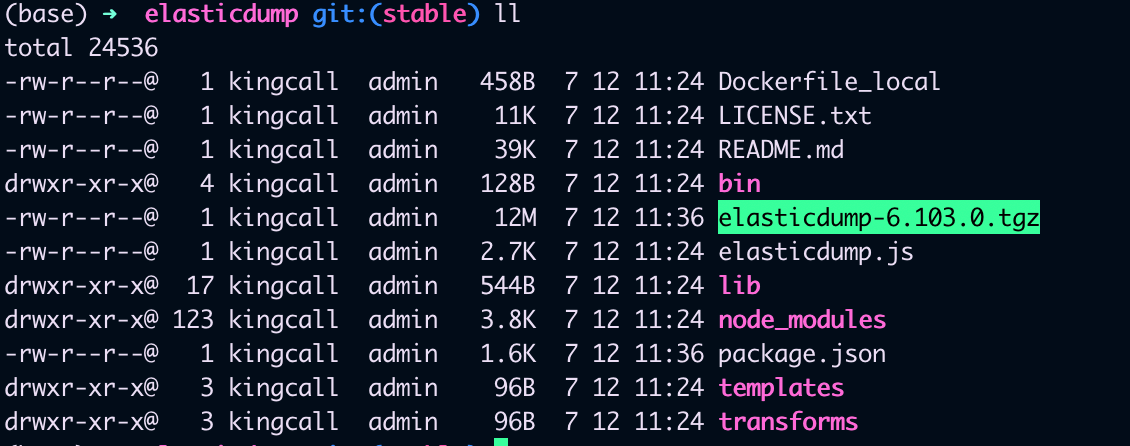-
ElasticSearch 数据迁移工具elasticdump
ElasticSearch 数据迁移工具elasticdump
Elasticdump 是一个用于导入和导出 Elasticsearch 数据的命令行工具。它提供了一种方便的方式来在不同的 Elasticsearch 实例之间传输数据,或者进行数据备份和恢复。
使用 Elasticdump,你可以将 Elasticsearch 索引中的数据导出为 JSON 文件,或者将 JSON 文件中的数据导入到 Elasticsearch 索引中。它支持各种选项和过滤器,用于指定源和目标,包括索引模式、文档类型、查询过滤器等等。
主要特征包括
- 支持在Elasticsearch实例或者集群之间传输和备份数据。可以将数据从一个集群复制到另一个集群。
- 支持不同格式的数据传输,包括JSON、NDJSON、CSV、备份文件等。
- 可以通过命令行或者程序化的方式使用。命令行方式提供了便捷的操作接口。
- 支持增量式同步,只复制目标集群中不存在的文档。
- 支持各种认证方式连接Elasticsearch,如basic auth、Amazon IAM等。
- 支持多线程操作,可以加快数据迁移的速度。
- 开源免费,代码托管在GitHub上。
一、安装node
首先获取安装包
wget https://nodejs.org/dist/v16.14.0/node-v16.14.0-linux-x64.tar.xz tar axf node-v16.14.0-linux-x64.tar.xz -C /usr/local/ mv /usr/local/node-v16.14.0-linux-x64 /usr/local/node- 1
- 2
- 3
然后配置环境变量
vim /etc/profile export NODE_HOME=/usr/local/node export PATH=$NODE_HOME/bin:$PATH- 1
- 2
- 3
接下来刷新环境变量,然后测试一下安装是否完成
source /etc/profile node -v npm -v- 1
- 2
- 3
如果是mac 的话可以使用
brew安装brew install node@16- 1
二、在线安装elasticdump
执行下面的命令安装
npm install elasticdump -g- 1
使用下面的命令查看安装目录
npm root -g- 1
我的位置在这里
/opt/homebrew/lib/node_modules
三、离装elasticdump
这里的原理是将node安装包和elasticdump安装报复制到需要离线安装的服务器。
- 获取node 的离线安装包进行安装即可,参考第一步
- 获取elasticdump的安装包安装,所以我们首选需要一个打包工具
npm install -g npm-pack-all- 1
然后我们切换到上面elasticdump的安装路,打包elasticdump,会在当前目录生成
elasticdump-6.103.0.tgz这样一个压缩包,这就是我们离线安装需要的包cd /opt/homebrew/lib/node_modules/elasticdump/ npm-pack-all- 1
- 2

到这里我们看到离线包已经生成好了,接下来我们复制到我们之前已经安装好node 的机器上,执行下面的命令
npm install elasticdump-6.103.0.tgz- 1
后面为了方便使用,我们可以配置一下elasticdump的环境变量
vim ~/.bashrc # 追加以下内容 #node export DUMP_HOME=/opt/homebrew/lib/node_modules/elasticdump/ export PATH=$DUMP_HOME/bin:$PATH # 刷新 source ~/.bashrc- 1
- 2
- 3
- 4
- 5
- 6
- 7
四、使用elasticdump
这里的使用主要分为两种,一种是数据备份,一种是数据迁移
- 备份主要指的是生成备份的数据文件,在需要的时候进行还原
- 数据迁移是指将原来索引里的数据迁移到新的索引
其实数据备份也能达到数据迁移的目的,但是在两个环境的网络不通的时候我们只能使用数据备份
我们安装成功后,在elasticdump的bin目录下其实有两个工具,一个是
elasticdump另外一个是multielasticdump
数据迁移
迁移索引
elasticdump \ --input=http://192.168.1.140:9200/source_index \ --output=http://192.168.1.141:9200/target_index \ --type=mapping- 1
- 2
- 3
- 4
迁移数据
elasticdump \ --input=http://192.168.1.140:9200/source_index \ --output=http://192.168.1.141:9200/target_index \ --type=data \ --limit=2000 # 每次操作的objects数量,默认100,数据量大的话,可以调大加快迁移速度- 1
- 2
- 3
- 4
- 5
这个命令会将源 Elasticsearch 实例中的 “my_index” 索引的所有数据导出,并保存到 “/path/to/output.json” 的 JSON 文件中。
--input:指定输入的 Elasticsearch 实例和索引。可以是一个 URL,也可以是本地 Elasticsearch 实例的路径。--output:指定输出的文件路径,数据将保存为一个 JSON 文件。--type:指定要导出的数据类型,通常为 “data” 表示文档数据。
你还可以使用其他选项来进一步控制导出过程,如
--query,--size,--limit,--filter等,具体取决于你的需求。可以通过运行elasticdump --help命令来数据备份
导出索引和数据
elasticdump \ --input=http://192.168.1.140:9200/source_index \ --output=/data/source_index_mapping.json \ --type=mapping elasticdump \ --input=http://192.168.1.140:9200/source_index \ --output=/data/source_index.json \ --type=data \ --limit=2000- 1
- 2
- 3
- 4
- 5
- 6
- 7
- 8
- 9
导入索引和数据
elasticdump \ --input=/data/source_index_mapping.json \ --output=http://192.168.1.141:9200/source_index \ --type=mapping elasticdump \ --input=/data/source_index.json \ --output=http://192.168.1.141:9200/source_index \ --type=data \ --limit=2000- 1
- 2
- 3
- 4
- 5
- 6
- 7
- 8
- 9
- 10
其他用法
还有其他使用的细节,例如压缩,指定query 什么的,我们可以参考下面的例子
# Copy an index from production to staging with analyzer and mapping: elasticdump \ --input=http://production.es.com:9200/my_index \ --output=http://staging.es.com:9200/my_index \ --type=analyzer elasticdump \ --input=http://production.es.com:9200/my_index \ --output=http://staging.es.com:9200/my_index \ --type=mapping elasticdump \ --input=http://production.es.com:9200/my_index \ --output=http://staging.es.com:9200/my_index \ --type=data # Backup index data to a file: elasticdump \ --input=http://production.es.com:9200/my_index \ --output=/data/my_index_mapping.json \ --type=mapping elasticdump \ --input=http://production.es.com:9200/my_index \ --output=/data/my_index.json \ --type=data # Backup and index to a gzip using stdout: elasticdump \ --input=http://production.es.com:9200/my_index \ --output=$ \ | gzip > /data/my_index.json.gz # Backup the results of a query to a file elasticdump \ --input=http://production.es.com:9200/my_index \ --output=query.json \ --searchBody="{\"query\":{\"term\":{\"username\": \"admin\"}}}" # Specify searchBody from a file elasticdump \ --input=http://production.es.com:9200/my_index \ --output=query.json \ --searchBody=@/data/searchbody.json # Copy a single shard data: elasticdump \ --input=http://es.com:9200/api \ --output=http://es.com:9200/api2 \ --input-params="{\"preference\":\"_shards:0\"}" # Backup aliases to a file elasticdump \ --input=http://es.com:9200/index-name/alias-filter \ --output=alias.json \ --type=alias # Import aliases into ES elasticdump \ --input=./alias.json \ --output=http://es.com:9200 \ --type=alias # Backup templates to a file elasticdump \ --input=http://es.com:9200/template-filter \ --output=templates.json \ --type=template # Import templates into ES elasticdump \ --input=./templates.json \ --output=http://es.com:9200 \ --type=template # Split files into multiple parts elasticdump \ --input=http://production.es.com:9200/my_index \ --output=/data/my_index.json \ --fileSize=10mb # Import data from S3 into ES (using s3urls) elasticdump \ --s3AccessKeyId "${access_key_id}" \ --s3SecretAccessKey "${access_key_secret}" \ --input "s3://${bucket_name}/${file_name}.json" \ --output=http://production.es.com:9200/my_index # Export ES data to S3 (using s3urls) elasticdump \ --s3AccessKeyId "${access_key_id}" \ --s3SecretAccessKey "${access_key_secret}" \ --input=http://production.es.com:9200/my_index \ --output "s3://${bucket_name}/${file_name}.json" # Import data from MINIO (s3 compatible) into ES (using s3urls) elasticdump \ --s3AccessKeyId "${access_key_id}" \ --s3SecretAccessKey "${access_key_secret}" \ --input "s3://${bucket_name}/${file_name}.json" \ --output=http://production.es.com:9200/my_index --s3ForcePathStyle true --s3Endpoint https://production.minio.co # Export ES data to MINIO (s3 compatible) (using s3urls) elasticdump \ --s3AccessKeyId "${access_key_id}" \ --s3SecretAccessKey "${access_key_secret}" \ --input=http://production.es.com:9200/my_index \ --output "s3://${bucket_name}/${file_name}.json" --s3ForcePathStyle true --s3Endpoint https://production.minio.co # Import data from CSV file into ES (using csvurls) elasticdump \ # csv:// prefix must be included to allow parsing of csv files # --input "csv://${file_path}.csv" \ --input "csv:///data/cars.csv" --output=http://production.es.com:9200/my_index \ --csvSkipRows 1 # used to skip parsed rows (this does not include the headers row) --csvDelimiter ";" # default csvDelimiter is ','- 1
- 2
- 3
- 4
- 5
- 6
- 7
- 8
- 9
- 10
- 11
- 12
- 13
- 14
- 15
- 16
- 17
- 18
- 19
- 20
- 21
- 22
- 23
- 24
- 25
- 26
- 27
- 28
- 29
- 30
- 31
- 32
- 33
- 34
- 35
- 36
- 37
- 38
- 39
- 40
- 41
- 42
- 43
- 44
- 45
- 46
- 47
- 48
- 49
- 50
- 51
- 52
- 53
- 54
- 55
- 56
- 57
- 58
- 59
- 60
- 61
- 62
- 63
- 64
- 65
- 66
- 67
- 68
- 69
- 70
- 71
- 72
- 73
- 74
- 75
- 76
- 77
- 78
- 79
- 80
- 81
- 82
- 83
- 84
- 85
- 86
- 87
- 88
- 89
- 90
- 91
- 92
- 93
- 94
- 95
- 96
- 97
- 98
- 99
- 100
- 101
- 102
- 103
- 104
- 105
- 106
- 107
- 108
- 109
- 110
- 111
- 112
- 113
- 114
- 115
- 116
- 117
- 118
- 119
常用参数
--direction dump/load 导出/导入 --ignoreType 被忽略的类型,data,mapping,analyzer,alias,settings,template --includeType 包含的类型,data,mapping,analyzer,alias,settings,template --suffix 加前缀,es6-${index} --prefix 加后缀,${index}-backup-2018-03-13- 1
- 2
- 3
- 4
- 5
总结
elasticdump是ElasticSearch提供的一个工具,我们主要可以用来完成
- 数据备份
- 数据迁移
这一节我们主要介绍了elasticdump的安装和使用,还有就是,Elasticdump 是一个第三方工具,不是官方的 Elasticsearch 产品。虽然它对某些用例很有帮助,但在使用之前,确保与你的 Elasticsearch 版本兼容,并查阅工具的文档以了解任何特定的注意事项或限制。
总体来说,elasticdump是一个非常实用的数据迁移和备份工具。它可以帮助我们轻松地在不同Elasticsearch集群之间进行数据迁移,实现集群之间的无缝数据同步。
-
相关阅读:
Airflow用于ETL的四种基本运行模式, 2022-11-20
【MediaSoup---源码篇】(二)Router
实战|轻松用 Python 开发一个简单有趣的聊天小程序
Hadoop(三)通过C#/python实现Hadoop MapReduce
解决window电脑使用IKE VPN登录时显示上下文已过期,不能再用了的方法。
看一遍学会Vue结合axios使用mockjs
竖式问题 rust解法
动态顺序表的代码实现
C#调用WebService的方法介绍
Vue3+ts——制作好看的动画Loading以及随机背景效果
- 原文地址:https://blog.csdn.net/king14bhhb/article/details/131716101
